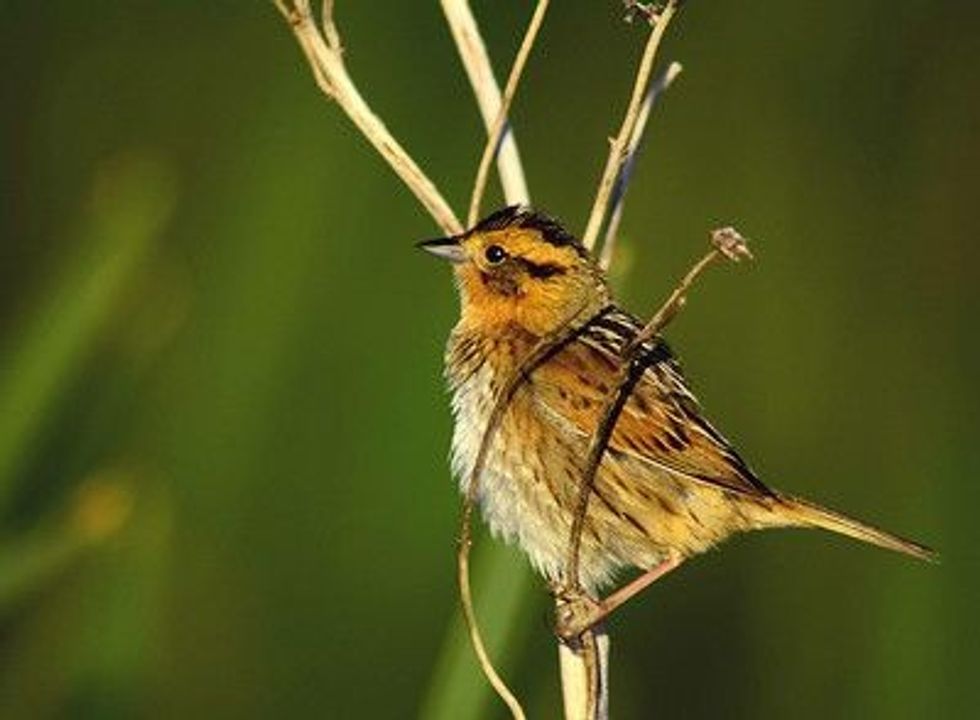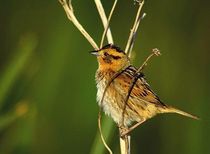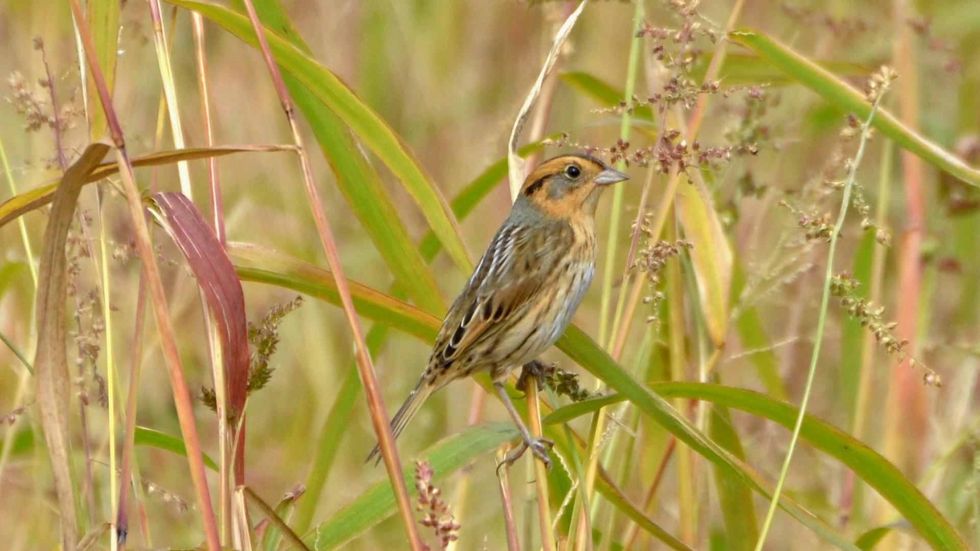Nelson's sparrow (Ammospiza nelsoni; Ammodramus nelsoni) is a small bird that belongs to the order Passeriformes, family Passerellidae. These birds were known as Nelson's sharp-tailed sparrow along with the Saltmarsh sparrow before they were separated into two different species.
They are divided into three subspecies which can be found all over America, Mexico, and Canada, which they use as a migration spot. Due to this, Nelson's sharp-tailed sparrow range is vast in nature.
These small birds forage in marshy swampland and dense vegetation whey they forage for food such as aquatic insects, small invertebrates, and amphipods.
As of now, these birds are listed as a Least Concern species on the IUCN Red List but are facing a steep decline in population due to a loss of environment that is caused by deforestation and other factors such as human settlements which have led to them being displaced.
Hopefully, with proper conservation efforts, these birds will get back to thriving in their natural habitat range.
If you like this article about Nelson's sparrow, then do check out these articles about the blue jay and the palm cockatoo.
Nelson's sparrow (Ammospiza nelsoni; Ammodramus nelsoni) is a small bird that belongs to the order Passeriformes, family Passerellidae. These birds were known as Nelson's sharp-tailed sparrow along with the Saltmarsh sparrow before they were separated into two different species.
They are divided into three subspecies which can be found all over America, Mexico, and Canada, which they use as a migration spot. Due to this, Nelson's sharp-tailed sparrow range is vast in nature.
These small birds forage in marshy swampland and dense vegetation whey they forage for food such as aquatic insects, small invertebrates, and amphipods.
As of now, these birds are listed as a Least Concern species on the IUCN Red List but are facing a steep decline in population due to a loss of environment that is caused by deforestation and other factors such as human settlements which have led to them being displaced.
Hopefully, with proper conservation efforts, these birds will get back to thriving in their natural habitat range.
If you like this article about Nelson's sparrow, then do check out these articles about the blue jay and the palm cockatoo.
Nelson's Sparrow Interesting Facts
What type of animal is a Nelson's sparrow?
The Nelson's sparrow (Ammospiza nelsoni) is a small bird species that are found in North America and Canada.
Nelson's sparrow and Nelson's sharp-tailed sparrow were until recently, split into two species. After the separation, these birds are distinguished as Nelson's sparrow and the Saltmarsh sparrow.
This species can are commonly known by their scientific name of Ammospiza nelsoni, but the name Ammodramus nelsoni, which is usually linked with the name of Nelson's sharp-tailed sparrow, can also be used to describe them as it is a synonym to the scientific name.
Furthermore, Nelson's sparrow is divided into three subspecies of A. n. nelsoni, A. n. altera, and A. n. subvirgata.
What class of animal does a Nelson's sparrow belong to?
These birds falls under the Aves class of animals that mostly consists of bird species.
How many Nelson's sparrows are there in the world?
Currently, the estimated population of these birds in the North American, Canadian, and Mexican habitat range is estimated to be around 1,000,000 individuals. The non-breeding and breeding bird count is present in this vast population range.
Even though Nelson's sparrow is a species of birds of North America, a large breeding population is found in Canada because of the wide distribution of freshwater marshes and coastal regions.
Due to these sparrows being divided into three different subcategories their population distribution is fragmented throughout North America and Canadian provinces. Various observations have noted that these birds are migratory and will migrate to the southern Atlantic coastal regions during the winter season in search of a breeding ground and in the search for food.
Due to this vast migratory range, the population of this bird is vastly distributed in both the North American and Canadian regions.
Where does a Nelson's sparrow live?
Once lumped under the same species name of sharp-tailed sparrow with the saltmarsh sparrow, these species have a wide distribution range and often go through the process of migration during the winter season as they leave their summer homes to search for a new breeding range or for newer foraging grounds.
These sparrow species are often found in the southern range of Hudson Bay, all the way to the Atlantic Coast.
During the summer these sparrows migrate to northern Plains and south-central Canada. In winter, the sparrows fly along the Atlantic and coastal regions of the Gulf coast.
In North American regions these birds can be found in South Dakota, Minnesota, New York, and winters from Delaware to Texas as they cross into the Canadian regions of Manitoba, southern Quebec, New Brunswick, and Maine.
In South Dakota, these sparrows are often found during the breeding season and are a rare migrant species that make the state their habitat.
What is a Nelson's sparrow's habitat?
These North American birds, much like their cousin, the saltmarsh sparrow, live near freshwater marshes during the breeding season in summer. In the winter their breeding and migration ground change from freshwater marshes to saltwater marshes.
In the center of the continent of North America, these sparrows make saltmarsh and freshwater wetland their habitat, mainly in marshes with dense vegetation such as cordgrass and reeds. They can also be found in wet fields and in the Atlantic coast can be found in marshes as well as wet fields.
Who do Nelson's sparrows live with?
Nelson's sparrow is a solitary bird species and males and females come together during the breeding season. These North American birds are well-known for their vast migration range which covers large parts of North America including South Dakota, New York, Minnesota, and the Canadian region of Hudson Bay.
They often fly south to the large marsh habitats crossing the Gulf Coast and the southern Atlantic coast.
Males are non-territorial and have overlapping habitats as they share a common foraging ground with other sparrows. During this migration period, these sparrows can be seen in the search for food in groups of 20-40 birds but can reach a large number of at least 100 birds in a large foraging ground.
How long does a Nelson's sparrow live?
The lifespan of Nelson's sparrow (Ammodramus nelsoni) species is between six to 10 years in the wild. Their lifespan in captivity is unknown.
How do they reproduce?
The sexual maturity of these birds is currently unknown. These birds have a breeding period that takes place during the spring and summer months.
The males take no part in the creation of a nest and it is usually the female that makes a nest alone. The nest of these birds is located several feet above ground level to protect the nest from water fluctuations by the females.
Nelson's sparrows are polygynous in nature and have a competition to mate with each other. Males will hover over an area in the search for female companions.
After finding a suitable female, the male will attempt to mate with her in a forceful way. The females, if unreceptive, will shrug the males off and fly away.
Since they are polygamous, several males will try to mate with a female in a short period. Even though the mating is somewhat forced, receptive females will crouch and prepare herself for copulation if she is receptive of a male.
After copulation, the females will lay two to six eggs in early summer. The incubation period for the eggs is 10-11 days and after a further 11-12 days, the young can leave the nest.
What is their conservation status?
Currently, Nelson's sparrows have a status of a Least Concern species on the IUCN Red List because of the vast habitat range that makes up a large population of these birds of North America.
However, even though they are estimated at a stable population range, they are slowly losing their numbers due to human interference which leads to habitat loss.
The conversion of marsh and grassland for domestic and agricultural purposes has led to them being displaced from their marsh habitats.
As a migratory species of birds, Nelson's sparrows are protected under the United States Migratory Bird Act.
Nelson's Sparrow Fun Facts
What do Nelson's sparrows look like?
Nelson's sparrow has a plumage that is pale gray in the upper back part of their bodies with a pale color tone on the underside which is tipped off with a faint color streak on the breast.
The breeding coloration of these birds is a strong yellow that covers the throats and the breast, sides with a faint streak on the flanks of the body alongside the breast.
Females are duller than males.

How cute are they?
These birds are an absolute visual treat for avid bird watchers as their small size and coloration give these birds a cute appearance much like most of the members of the sparrow family.
How do they communicate?
These birds use songs to communicate with each other, mostly during the breeding season. These songs are relegated to communication only as they do not apply to the establishment of territories.
Nelson's sparrow in flight can often be heard singing. The females of this species use their chirps as warning calls to alert the young of the presence of a predator. These warning calls are also used to thwart off males from their nests to protect their young.
How big is a Nelson's sparrow?
A full-grown adult Nelson's sparrow reaches a height of 4-5 in (10.1-12.7 cm) and has a wingspan of 7.8-11.8 in (19.8-30 cm). These birds are twice as large as the bee hummingbird with reaches a body size of 2.1-2.4 in (5.3-6 cm).
How fast can a Nelson's sparrow fly?
The flight speed of Nelson's sparrow is unknown. These birds can be found wading through vegetation in their marsh habitats where they forage the waters for aquatic plants and insects.
Most sparrow species can reach a flight speed of 23.9 mph (38.4 kph) normally and can reach 31 mph (49.8 kph) at a maximum flight speed, this flight speed is what makes sparrows somewhat of a special bird.
How much does a Nelson's sparrow weigh?
These lightweight birds have a maximum body mass between 0.6-0.7 oz (17-19.8 g).
What are their male and female names of the species?
There is no specific name assigned to the male or female members of these members of the sparrow family.
What would you call a baby Nelson's sparrow?
A baby Nelson's sparrow is called a chick.
Juveniles have a plumage that is similar to that of an adult, but they have a crown that is black and an orange tone can be found on their bodies that covers the breast, rump, and upper tail.
What do they eat?
Nelson's sparrow is omnivorous in nature and has a diet that consists of plants, seeds, and animals. These birds are somewhat wading in nature as they forage in marsh habitats for amphipods, spiders, and insects. In the winter, they feed specifically on grains and seeds.
Are they poisonous?
No, they are not poisonous.
Would they make a good pet?
No, these sparrows are wild birds and are not fit for a captive lifestyle. They are also under strict conservation effort which makes owning them illegal in certain parts of the world.
Did you know...
Sparrows play a vital role in the ecosystem as they feed on small insects that destroy vegetation, as a result, they are essential to the conservation of their ecosystem.
Nelson's sparrow is named after Edward William Nelson to pay tribute to his extensive work in the classification of birds.
LeConte's sparrow is the smallest member of the sparrow family.
The oldest chipping sparrow was recorded to live for nine years and nine months! This lifespan is high compared to how most of these birds die within the first few weeks of their lives.
The Northern harrier, short-eared owl, and the common garter snake are some of the known predators of Nelson's sparrow.
How did Nelson's sparrows get their name?
Nelson's sparrow was named after the American naturalist Edward William Nelson who was the president of the American Ornithological Union for a short period of time.
What's the difference between male and female Nelsons sparrows?
Male and female Nelson's sparrow can be differentiated through their plumage as males have a darker plumage compared to females. A black band is visible on the males' neck which the females lack.
Here at Kidadl, we have carefully created lots of interesting family-friendly animal facts for everyone to discover! For more relatable content, check out these devil fish facts and candiru facts for kids.
You can even occupy yourself at home by coloring in one of our free printable sunfish coloring pages.
Second image by Andy Reago & Chrissy McClarren.









